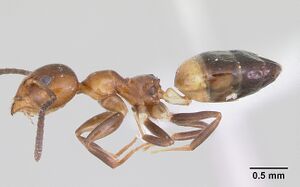Axinidris mlalu
| Axinidris mlalu | |
|---|---|

| |
| Scientific classification | |
| Kingdom: | Animalia |
| Phylum: | Arthropoda |
| Class: | Insecta |
| Order: | Hymenoptera |
| Family: | Formicidae |
| Subfamily: | Dolichoderinae |
| Genus: | Axinidris |
| Species: | A. mlalu |
| Binomial name | |
| Axinidris mlalu Snelling, R.R., 2007 | |
The types were collected from beating vegetation in rainforest. Nothing more is known about the biology of Axinidris mlalu.
Identification
Snelling (2007) - Scape shaft, pronotum and gastral terga without erect hairs; distance between apices of propodeal spines less than distance between propodeal spiracles; gastral tergum 1 yellow, segments 2-4 dark brown.
The sharply contrastingly bicolored gaster and lack of erect hairs on both the mesosomal and gastral dorsa are distinctive for this species
Keys including this Species
Distribution
Latitudinal Distribution Pattern
Latitudinal Range: 2.366666667° to 2.366666667°.
| North Temperate |
North Subtropical |
Tropical | South Subtropical |
South Temperate |
- Source: AntMaps
Distribution based on Regional Taxon Lists
Afrotropical Region: Central African Republic (type locality).
Distribution based on AntMaps
Distribution based on AntWeb specimens
Check data from AntWeb
Countries Occupied
| Number of countries occupied by this species based on AntWiki Regional Taxon Lists. In general, fewer countries occupied indicates a narrower range, while more countries indicates a more widespread species. |

|
Estimated Abundance
| Relative abundance based on number of AntMaps records per species (this species within the purple bar). Fewer records (to the left) indicates a less abundant/encountered species while more records (to the right) indicates more abundant/encountered species. |

|
Biology
Species of Axinidris appear to nest exclusively within hollow plant stems, both living and dead, and in rotten wood. They are found in forested areas throughout the Afrotropical region, but are most abundant and diverse in the moist equatorial forests. Workers are primarily arboreal foragers, but may occasionally forage in ground litter.
Castes
Known only from the worker caste.
Worker
Images from AntWeb
   
| |
| Holotype of Axinidris mlalu. Worker. Specimen code casent0403547. Photographer April Nobile, uploaded by California Academy of Sciences. | Owned by CAS, San Francisco, CA, USA. |
Nomenclature
The following information is derived from Barry Bolton's Online Catalogue of the Ants of the World.
- mlalu. Axinidris mlalu Snelling, R.R. 2007: 566 (w.) CENTRAL AFRICAN REPUBLIC.
- Type-material: holotype worker.
- Type-locality: Central African Republic: Songha-Mbaéré Pref., Parc Nat. Dzanga-Ndoki, 37.9 km. 169° S Lidjombo, 2°22’N, 16°10’E, 360 m., 20-28.v.2000, #4128 (B.L. Fisher).
- Type-depository: CASC.
- Distribution: Central African Republic.
Unless otherwise noted the text for the remainder of this section is reported from the publication that includes the original description.
Description
Worker
(mm) (n - 1). HW 0.74; HL 0.86; SL 0.68; EL 0.21; OVD 0.31; PNW 0.49; PPW 0.36; WL 1.03. Indices. CI 87; CNI 100; SI 91; OI 28.
Front of head moderately shiny, weakly coriarious and strigulate between sparse minute punctures; gena shinier and with few strigulae, malar area more strongly coriarious. Antennal scape without erect hairs; each frontal carina with 1 pair of long erect hairs; upper frons with a single submedian pair of long hairs below vertex margin. Mesosomal dorsum without erect hairs. Pronotal disc smooth and shiny. Mesonotum shiny, anteriorly smooth, posteriorly sharply punctate. Mesepisternum shiny, with faint longitudinal rugae.
Metepisternum densely and relatively coarsely punctate. Propodeum contiguously finely punctate; dorsal face slightly convex in profile; medial carina absent from dorsal face except at summit of declivity, where it is low and broadly rounded; medial carina present on declivitous face; spiracular prominence well-developed, spiracular opening directly obliquely distad; propodeal teeth short and distance between their bases less than distance between spiracles.
Gastral terga shiny and unsculptured except for close fine piligerous punctures; all terga without erect hairs.
Head light brownish with yellowish clypeus and mandibles; mesosoma light brownish, paler on pronotum and sides; gaster dark brown but tergum 1 yellow, concolorous with petiole.
Type Material
Holotype worker, CENTRAL AFRICAN REPUBLIC, Songha-Mbaéré Pref., Parc National Dzanga-Ndoki, "37.9 km 169°S" Lidjombo, 2°22'N 16°10'E, 360m, 20-28 May 2000 (B.L. Fisher, #4128), beating low vegetation, rainforest, in California Academy of Sciences.
Etymology
The name is an arbitrary combination to be treated as a noun in apposition
References
References based on Global Ant Biodiversity Informatics
- Snelling, R. R. 2007. A review of the arboreal Afrotropical ant genus Axinidris, pp. 551-579. In Snelling, R. R., B. L. Fisher, and P. S. Ward (eds). Advances in ant systematics (Hymenoptera: Formicidae): homage to E. O. Wilson 50 years of contributions. Memoirs of the American Entomological Institute, 80.

